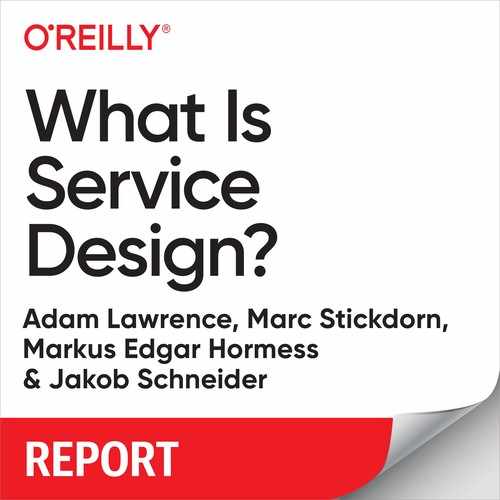Chapter 4. Summary: The Principles of Service Design
Service design has many shapes in practice, and no two practitioners, departments, or agencies have exactly the same approach—thank goodness. But an examination of the state of the discipline today shows six key principles that turn up again and again. Service design is:
- Human-centered
Designers should consider the experience of all the people affected by the service.
Service design remains a highly “user-centered” approach, but not only user needs must be considered in a service design project. To make this clear, it is better to speak of service design as being “human-centered,” clearly including the service provider (employees) as well as the customers and/or users and any other stakeholders and even noncustomers who are impacted by the service.
- Collaborative
Stakeholders of various backgrounds and functions should be actively engaged in the service design process.
Service design is collaborative and cross-disciplinary in nature, cutting through the silos of organizations to shape meaningful value. It serves as a language to connect people with different skills and viewpoints.
- Iterative
Service design is an exploratory, adaptive, and experimental approach, iterating toward implementation.
One key characteristic of the service design approach is the emphasis on iteration—starting with small, cheap attempts and experiments, allowing them to fail, learning from the failure, and adapting the process along the way. This is often hard for people to grasp, as many of us come from a decide–plan–do background, but it is an essential characteristic of a design-led approach.
- Sequential
The service should be visualized and orchestrated as a sequence of interrelated actions.
Experience plays a central role in service design. Journey mapping is still the most visible and well-known tool in the field, helping teams focus on the interplay and relationships between the various moments, steps, or “touchpoints”1 that make up a service experience.
- Real
Needs should be researched in reality, ideas prototyped in reality, and intangible values evidenced as physical or digital reality.
Service design is an essentially practical approach, as we can see when Stanford colleagues describe design thinking as having a “bias toward action,” or when participants at jamming events2 wear T-shirts emblazoned with “doing, not talking” in many languages. It is founded on activities of research and prototyping, not on opinions or lofty concepts. And in their results, service designers try to make the invisible value of offerings tangible to audiences.
- Holistic
Services should sustainably address the needs of all stakeholders through the entire service and across the business.
The word “holistic” is often used to remind us that service designers aspire to shape the entirety of a service, not just patch individual problems (though that might be a good starting point). They also aim to address the complete needs of the customer, not only superficial symptoms, making service design very relevant to the corporate identity and goals of the organization. This leads to the imminent and central need for service design to be relevant to business. Although it is based on creating better experiences, it does this by understanding (and reshaping) backstage processes while considering technological opportunities as well as the business goals of the organization. No service design can be successful or sustainable if it does not make sense on the spreadsheet, as well as in the sketchbook.
In Conclusion
Service design is a practical approach to the creation and improvement of the offerings made by organizations. It has much in common with (or is identical to) several other approaches, like design thinking, experience design, and user experience design. It has its origins in the design studio, and harmonizes well with service-dominant logic.3 It is a human-centered, collaborative, interdisciplinary, iterative approach that uses research, prototyping, and a set of easily understood activities and visualization tools to create and orchestrate experiences that meet the needs of the business, the user, and other stakeholders.
To learn more, check out communities like the Service Design Network and the Global Jams.
1 See the textbox “Steps, touchpoints, and moments of truth” in #TiSDD Section 3.3, Journey maps.
2 The Global Service Jam, an international volunteer-run design event that takes place in more than 100 cities each year, has played an important part in disseminating the service design approach worldwide.
3 While we refer to it often, we view service-dominant logic not as a school of thought superseding other theories, but rather as a valuable component within a growing, changing, and patchy body of knowledge. As Achrol and Kotler say: “Some philosophers like Popper, Feyerabend, and Lakatos forcefully argue for theoretical diversity and against dominant paradigms. … Popper (1959) points out that because we never know for certain that our theories are correct, we should proliferate our theories as much as possible to encourage the growth of scientific knowledge.” Achrol, R. S., & Kotler, P. (2006). “The Service-Dominant Logic for Marketing: A Critique.” In R. F. Lusch & S. L. Vargo (eds.), The Service-Dominant Logic of Marketing: Dialog, Debate, and Directions (pp. 320–333). M. E. Sharpe, p. 331.
